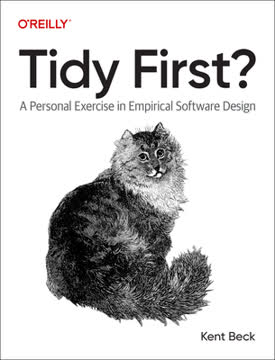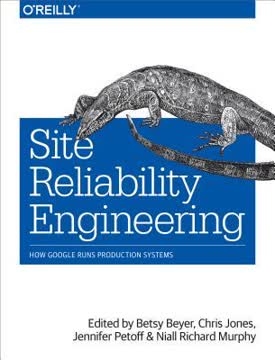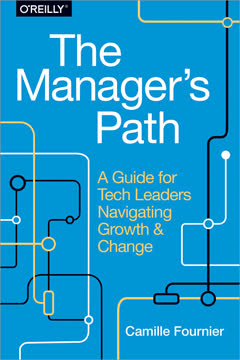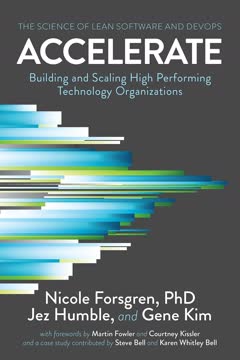Key Takeaways
1. Organizational design is the foundation of scalable engineering management
Organizational design is the attempt to understand why some create such energy and others create mostly heat: friction, frustration, and politics.
Optimal team structure. Engineering teams should ideally consist of 6-8 members during steady state. This size allows for effective collaboration while providing enough capacity to handle on-call rotations and maintain productivity. When forming new teams, grow an existing team to 8-10 members, then split it into two teams of 4-5 each. This approach ensures that new teams have a solid foundation and shared context.
Managerial span of control. Managers should typically support 6-8 engineers, while managers-of-managers should oversee 4-6 managers. This structure allows for active coaching, coordination, and strategic planning at each level. As organizations grow, it's crucial to maintain these ratios to prevent managers from becoming overwhelmed or disconnected from their teams' work.
2. Effective managers balance team size and performance metrics
Metrics are useful for narrowing the solution space that you explore in order to accomplish your investment goals.
Define clear goals. Establish well-structured goals that include a target, baseline, trend, and time frame. This approach provides context and allows stakeholders to evaluate progress effectively. For example: "In Q3, we will reduce time to render our frontpage from 600ms (p95) to 300ms (p95). In Q2, render time increased from 500ms to 600ms."
Balance investment and baseline metrics. Pair investment goals (improvements you want to make) with baseline metrics (current performance you want to maintain). This ensures that teams don't sacrifice long-term stability for short-term gains. For instance, while working to improve page load times, maintain a baseline metric for infrastructure costs to prevent unsustainable optimizations.
3. Implement systematic approaches to hiring and career development
Migrations are both essential and frustratingly frequent as your codebase ages and your business grows: most tools and processes only support about one order of magnitude of growth before becoming ineffective.
Structured hiring process. Develop a comprehensive hiring funnel that includes sourcing candidates, motivating them to apply, evaluating their skills, and closing offers. Instrument each stage of the process to identify bottlenecks and areas for improvement. Regularly review and optimize your hiring funnel metrics to ensure you're attracting and selecting the best candidates efficiently.
Career ladders and performance management. Create clear career ladders that outline expectations for each role and level within your organization. Implement a consistent performance management system that includes self-reviews, peer feedback, and manager evaluations. Conduct regular calibration sessions to ensure fair and consistent performance designations across teams and departments.
4. Foster a culture of continuous learning and improvement
The best learning doesn't always come directly from your manager, and one of the most important things a first team does is provide a community of learning.
Encourage knowledge sharing. Organize regular learning sessions, such as paper reading groups or tech talks, where team members can discuss new ideas and technologies. Create a culture where individuals are encouraged to share their expertise and learn from others' experiences.
Invest in personal growth. Support your team members' professional development by:
- Providing dedicated time for learning and experimentation
- Offering training budgets for conferences, courses, or certifications
- Encouraging participation in open-source projects or internal hackathons
- Implementing a mentorship program to facilitate knowledge transfer
5. Develop a toolkit for navigating change and solving complex problems
Systems thinking has been the most effective universal tool for reasoning through complex problems.
Systems thinking approach. Adopt systems thinking to analyze and solve complex organizational challenges. This involves:
- Identifying key components and their interactions
- Recognizing feedback loops and delays in the system
- Considering both short-term and long-term consequences of decisions
Change management strategies. Develop a toolkit for implementing and managing change within your organization:
- Clearly communicate the reasons for change and expected outcomes
- Involve key stakeholders in the planning process
- Provide necessary resources and support during transitions
- Monitor progress and adjust plans as needed
6. Create an inclusive environment through opportunity and membership
An inclusive organization is one in which individuals have access to opportunity and membership.
Equal access to opportunities. Implement structured processes for assigning important projects and roles to ensure fair access to growth opportunities. Use a transparent selection process that allows team members to apply for leadership positions and challenging assignments.
Foster a sense of belonging. Create an inclusive environment by:
- Organizing regular team events and social activities
- Supporting employee resource groups (ERGs) for underrepresented communities
- Conducting regular skip-level one-on-ones to gather feedback and address concerns
- Celebrating diverse perspectives and contributions within the team
7. Master the art of communication and strategic decision-making
A good vision is composed of: Vision statement, Value proposition, Capabilities, Solved constraints, Future constraints, Reference materials, Narrative.
Effective communication. Develop strong communication skills to articulate your vision, strategy, and decisions clearly:
- Craft concise and compelling vision statements
- Use data-driven narratives to support your proposals
- Tailor your message to different audiences (executives, peers, team members)
Strategic decision-making. Improve your decision-making process by:
- Gathering relevant data and considering multiple perspectives
- Analyzing potential trade-offs and long-term consequences
- Aligning decisions with organizational goals and values
- Communicating the rationale behind decisions transparently
8. Embrace systems thinking to address organizational challenges
The most effective way to provide opportunity to the members of your organization is through the structured application of good process.
Process design. Develop and implement effective processes that scale with your organization:
- Sprint planning and execution
- Roadmap development and stakeholder alignment
- Operational metrics tracking and analysis
- Regular team and cross-functional meetings
Continuous improvement. Regularly review and optimize your processes:
- Collect feedback from team members and stakeholders
- Analyze process effectiveness using relevant metrics
- Experiment with new approaches and tools
- Share learnings and best practices across the organization
9. Cultivate strong relationships and empower your team
Strong relationships > any problem
Build trust. Invest time in building strong relationships with your team members, peers, and stakeholders:
- Schedule regular one-on-ones and team-building activities
- Practice active listening and empathy
- Follow through on commitments and be transparent about challenges
Empower your team. Create an environment where team members feel empowered to make decisions and take ownership of their work:
- Delegate responsibilities and provide necessary resources
- Encourage experimentation and learning from failures
- Recognize and celebrate individual and team achievements
- Provide constructive feedback and support for growth
10. Balance technical expertise with people management skills
Management is an ethical profession, and our decisions matter, especially the hard ones.
Technical leadership. Maintain your technical skills to effectively guide and support your team:
- Stay informed about relevant technologies and industry trends
- Participate in architecture discussions and code reviews
- Contribute to technical decision-making and problem-solving
People management. Develop strong people management skills to nurture and grow your team:
- Practice effective coaching and mentoring techniques
- Address conflicts and performance issues promptly and fairly
- Create opportunities for skill development and career growth
- Balance individual needs with team and organizational goals
Last updated:
FAQ
What's "An Elegant Puzzle: Systems of Engineering Management" about?
- Focus on engineering management: The book addresses the unique challenges faced by engineering managers, such as team sizing, managing technical debt, and succession planning.
- Structured and human-centric approach: Will Larson combines structured management principles with a focus on human-centric thinking to create effective engineering organizations.
- Experience-based insights: Drawing from his experiences at companies like Digg, Uber, and Stripe, Larson provides practical advice for leaders at all levels.
- Balancing principles and practice: The book aims to help leaders create environments where engineers can thrive by balancing structured management principles with practical, real-world applications.
Why should I read "An Elegant Puzzle"?
- Practical guidance: The book offers actionable advice for solving complex management challenges in engineering environments.
- Broad applicability: While focused on engineering, the principles can be applied to management roles in various industries.
- Experienced author: Will Larson's insights are grounded in his extensive experience in leading engineering teams at major tech companies.
- Improving team dynamics: The book provides strategies for creating high-performing teams and improving organizational culture.
What are the key takeaways of "An Elegant Puzzle"?
- Team sizing and structure: Effective team sizing and structure are crucial for maintaining productivity and morale.
- Systematic problem-solving: Use systems thinking to address complex management challenges and improve organizational efficiency.
- Balancing short-term and long-term goals: Managers should focus on both immediate needs and long-term strategic planning.
- Importance of culture: Building an inclusive and supportive culture is essential for team success and individual growth.
How does Will Larson suggest managing technical debt?
- Migrations as a solution: Larson emphasizes the importance of migrations as a scalable solution to manage technical debt.
- De-risking and enabling: Start by de-risking the migration process and enabling teams with the right tools and documentation.
- Programmatic migration: Automate as much of the migration process as possible to reduce the burden on individual teams.
- Finishing migrations: Ensure that migrations are completed fully to avoid leaving teams with partially finished transitions.
What is Will Larson's approach to team sizing in "An Elegant Puzzle"?
- Optimal team size: Managers should support six to eight engineers to allow for effective coaching and team development.
- On-call rotations: Teams should have at least eight engineers to manage on-call rotations effectively.
- Avoid small teams: Teams with fewer than four members are not considered effective and should be avoided.
- Growth and splitting: Grow teams to eight to ten members before splitting them into smaller, more manageable teams.
How does "An Elegant Puzzle" address succession planning?
- Identify responsibilities: Start by identifying all the responsibilities and roles you currently fulfill.
- Close gaps: Determine which responsibilities can be delegated and work on closing any gaps in your team's capabilities.
- Document processes: Document key processes and ensure that others are trained to take over your responsibilities.
- Regular review: Conduct regular reviews of your succession plan to ensure it remains relevant and effective.
What are the best quotes from "An Elegant Puzzle" and what do they mean?
- "Management is an ethical profession": This quote emphasizes the responsibility managers have to create fair and supportive environments for their teams.
- "Strong relationships > any problem": Highlights the importance of building strong relationships to overcome challenges and foster collaboration.
- "Do the hard thing now": Encourages managers to tackle difficult issues head-on rather than postponing them, which can lead to larger problems.
- "People over process": Suggests that focusing on the people involved is more important than rigidly adhering to processes.
How does Will Larson suggest handling organizational risk?
- Identify and prioritize risks: Recognize the most pressing organizational risks and prioritize addressing them.
- Delegate solvable risks: Delegate risks that can be managed by others, but hold onto those that are particularly challenging.
- Create a plan: Work with your manager to create a plan for addressing key risks and set reasonable expectations.
- Accept imperfection: Understand that some risks will remain unresolved, and focus on making progress where possible.
What is the role of systems thinking in "An Elegant Puzzle"?
- Understanding complex systems: Systems thinking helps managers understand the interconnectedness of various elements within an organization.
- Stocks and flows: The book introduces the concepts of stocks and flows to analyze how changes accumulate over time.
- Feedback loops: Identifying feedback loops within systems can help managers predict and influence outcomes.
- Leveraged problem-solving: Systems thinking allows managers to focus on high-leverage problems that can have a significant impact on organizational performance.
How does "An Elegant Puzzle" suggest improving team productivity?
- Focus on core constraints: Identify and address the core constraints that limit team productivity.
- Consolidate efforts: Prioritize resources on one team at a time to maximize the impact of improvements.
- Maintain slack: Ensure teams have enough slack in their schedules to innovate and avoid burnout.
- Systematic improvements: Use a systematic approach to address productivity issues, rather than relying on quick fixes.
What is Will Larson's philosophy of management in "An Elegant Puzzle"?
- Ethical responsibility: Management is viewed as an ethical profession with a focus on fairness and support.
- Relationship building: Strong relationships are seen as the foundation for solving internal problems.
- Prioritizing people: Emphasizes the importance of focusing on people over rigid processes.
- Proactive problem-solving: Encourages managers to address difficult issues promptly and directly.
How does "An Elegant Puzzle" address the challenges of hypergrowth?
- Training and onboarding: Invest in training programs to quickly ramp up new hires and maintain productivity.
- Managing interruptions: Funnel interruptions into manageable areas and automate where possible to reduce distractions.
- Documentation culture: Foster a culture of documentation to minimize interruptions and improve knowledge sharing.
- Flexible systems: Design systems to be flexible and adaptable to avoid unnecessary rewrites and migrations.
Review Summary
An Elegant Puzzle receives mixed reviews, with ratings ranging from 2 to 5 stars. Praised for its practical advice on engineering management, the book is appreciated for its concise style and systems thinking approach. Critics note its disjointed structure, lack of coherent narrative, and occasional oversimplification. Many readers find value in the book's insights on team growth, organizational challenges, and career development. The beautiful physical design and recommended reading list are frequently highlighted as positives, while some reviewers question the applicability of advice to different company sizes and growth stages.
Similar Books










Download PDF
Download EPUB
.epub digital book format is ideal for reading ebooks on phones, tablets, and e-readers.





